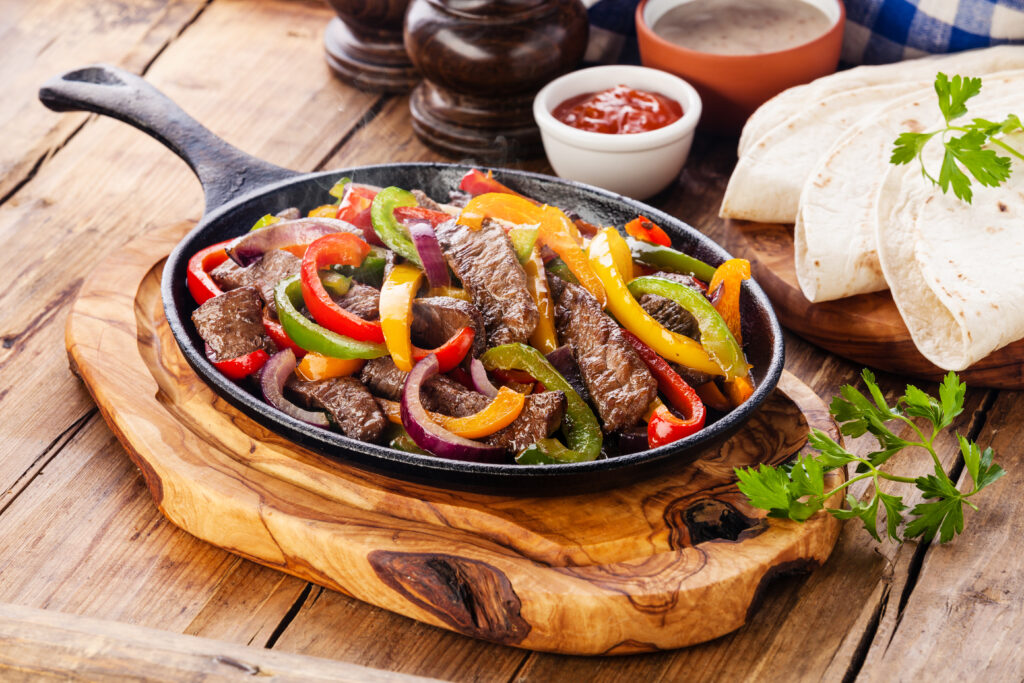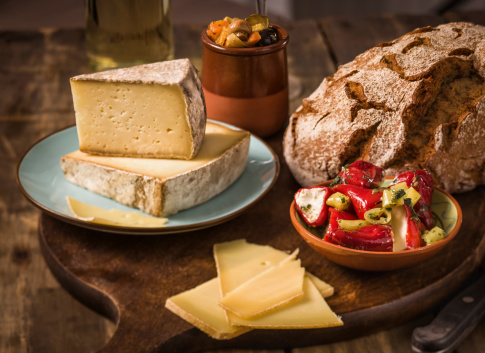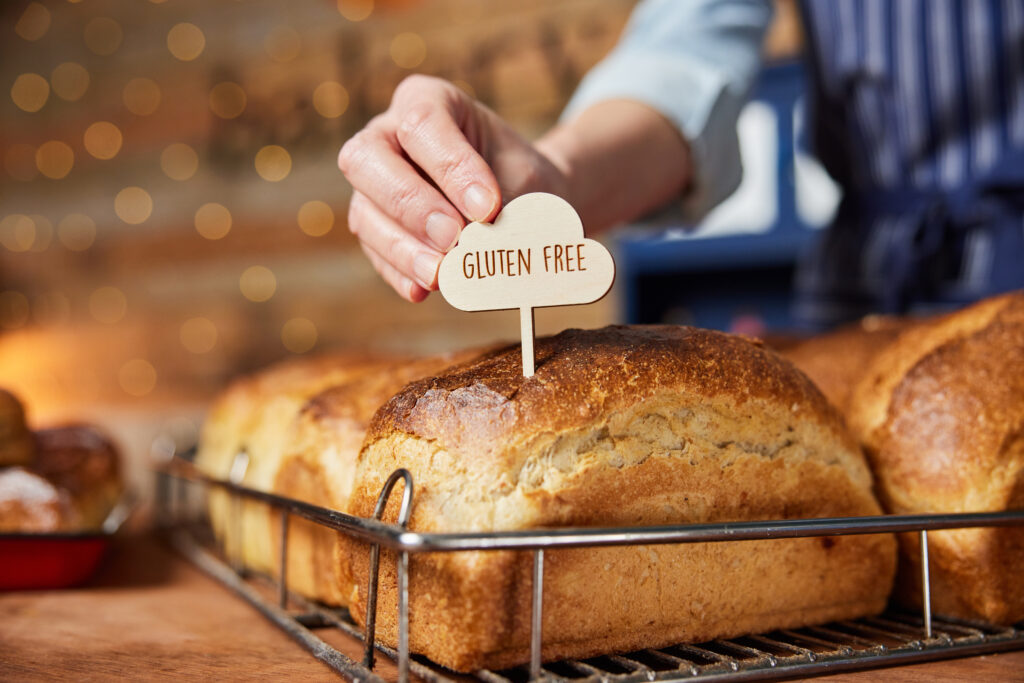
Welcome back to another exciting week of wallet-stretching meal options! As we dive into week four, we’re thrilled to continue our culinary journey, exploring delicious recipes, time-saving tips, and creative meal ideas. This week we are bringing two simple, yet flavorful meal options to your table. They were designed to feed four people at under $3.50 per person. The key to these meals is getting a few ingredients ready and then finishing with quick cooking– and we can help!
This week’s items:
2 packs Certified Angus Beef Steak (Buy one get one free)
1 box Ka Me Noodle Rice Sticks
1 bag PICS Frozen Broccoli (16 oz)
1 bag PICS Frozen Onions & Peppers (16 oz)
1 pack PICS Fajita Tortillas (10 oz)
1 bag PICS Shredded Cheese (8 oz)
1 pack McCormick Fajita Seasoning
1 jar Fage Sour Cream
1 pack Kikkoman Broccoli Beef Seasoning
Optional for a fun meal addition:
1 jar PICS Pizza Sauce
3 packs Thomas’ English Muffins (buy one get TWO free)
Smart set up:
Bowl for marinating or velveting meat
Large skillet or wok
Sharp knife/cutting board for slicing meat
Measuring spoons
Wooden spatula for stir-frying
Prep tips and hacks:
Cook rice or noodles according to package directions. Drain and set aside.
Hack: Freeze steak for 10-15 minutes. Remove from packaging to cutting board, and slice thinly across the grain. Slicing across the grain is part of ensuring it is tender and cooks quickly.
Meal #1: Steak Fajitas!
1 pack Certified Angus Beef
1 pack PICS Frozen Onions & Pepper (16 oz)
PICS Fajita Tortillas (10 oz)
PICS Shredded Cheese
Fage Sour Cream
McCormick Fajita Seasoning
Prepare fajita marinade in a bowl large enough for liquid and sliced steak. Reserve 2 tablespoons of marinade. Cut lime into wedges. Prepare flour tortillas to be warmed in the oven or microwave.
Tip – Cooking frozen veggies first allows for water to evaporate and veggies to brown. Skip this step if you want to cook together.
Heat 1 tablespoon oil in skillet or wok. When heated, carefully add frozen veggies to the pan, stir frying quickly to heat through and crisp. Remove from skillet when done, place in a bowl, add reserved marinade, and keep warm.
Heat 1 tablespoon oil in the skillet. Place marinated steak and marinade in the pan and stir fry on high heat until done. Discard any remaining marinade.
Return cooked vegetables to the pan, toss with cooked steak and heat through. Squeeze lime wedges over meat and vegetables and serve!
Meal #2: Beef and Broccoli
1 pack Certified Angus Beef Steak
1 box Ka Me Noddle Rice Sticks
1 bag PICS Frozen Broccoli
1 pack Kikkoman Broccoli Beef Seasoning Mix
Hack: Freeze steak for 10-15 minutes. Remove from packaging to cutting board, and slice thinly across the grain. Slicing across the grain is part of ensuring it is tender and cooks quickly.
Place sliced steak in a bowl and sprinkle with 1 ½ tsp baking soda per 8 oz. Return to the refrigerator for 30 minutes to allow meat to “velvet”, which tenderizes the meat. After 30 minutes, rinse meat slices and pat dry before seasoning or adding marinade for Beef and Broccoli.
Heat oil in large skillet or wok, and add frozen broccoli carefully, watching for splatter. Use wooden spoon or spatula to quickly toss and allow water to evaporate and broccoli to begin cooking. Add meat and marinade and continue stir frying until meat is brown and cooked, and all meat and vegetables are cooked and seasoned.
Leftover love – Make fried rice with leftover meat and/or scrambled eggs, rice and PICS frozen peas and carrots!
Stir fry frozen vegetables in a large skillet or wok. Scramble two eggs in a coffee cup and cook in the microwave. Add chopped leftover meat and rice to the vegetables, and the scrambled eggs. Season with two tablespoons of lower sodium soy sauce – done!
English Muffin Magic – A fun addition to this week’s meal ideas!
1 pack Thomas English Muffins (Be sure to purchase three to get buy one get two FREE)
1 bag PICS Shredded Cheese
1 jar PICS Pizza Sauce
Breakfast, lunch or snack attack – English muffins are a versatile, fun, and easy way to enjoy a quick bite. Try the Whole Grain or Lite versions to amp up the benefits, and the sky is the limit. Quick and convenient whenever you want to eat it! Toasted with nut butter and banana, or avocado and everything seasoning! Kid-friendly – Grab some PICS Pizza sauce and PICS Shredded Mozzarella and make mini English Muffin pizzas! Guaranteed fun for little and big kids 😊

Written by our friends at Green Mountain Energy
2024 is finally here, and with a new year comes new possibilities. As we look forward to the year ahead, we’re making a list of all the things we can accomplish together by making good choices for the planet. No matter where you are on your green journey, we’re here to help you take the next step.
Here are 4 eco-friendly choices you can make today that will have a positive impact on this beautiful planet.
1. Ditch the gas guzzler and drive an EV
Electric vehicles are more affordable than ever these days, so now is the perfect time to ditch your old gas-powered car for one that rides on pure electricity. Transportation is one of the largest sources of carbon emissions in the U.S., so buying an electric vehicle means plugging into a cleaner transportation landscape.
We can even help you out with EV buying experts, charging station maps and 100% solar energy plans tailored for electric vehicle drivers so you can live green and drive clean.
2. Avoid the landfill by composting your food waste
Food scraps and yard waste make up more than 30% of what we throw away. When these organic waste products reach landfills and start to decompose, they release harmful greenhouse gases like methane and carbon dioxide into the atmosphere, directly contributing to climate change. Why not use them to help your plants and garden grow instead?
3. Leave single-use plastic on the shelf and use reusables
Single-use plastic products like shopping bags and water bottles add tons of unnecessary trash to the waste stream every day. Next time you’re going out shopping, bring along reusable bags and carry a refillable water bottle wherever you go.
4. Shrink your carbon footprint by choosing 100% clean electricity
There’s no way around it: when we make cleaner choices for ourselves, we help make the planet greener. One of the best choices you can make for a cleaner planet is to commit to clean energy for your home.
By powering your home with 100% clean electricity, you’re cutting out one of the biggest sources of carbon emissions in your life. It’s a good choice that supports a healthier planet. When 2025 rolls around, you can say you did your part to help make our planet cleaner and greener.
We’ve partnered with Market 32 to offer a clean energy plan that rewards you with 10,000 AdvantEdge Rewards points ($100 value) after 2 months of service, and 1,000 points ($10 value) every 6 months for as long as you stay on your plan! Learn more here.

Can you believe we are already half way through January? As the new year unfolds, January brings with it a sense of renewal and the opportunity for a fresh start. You may be watching what you eat and watching what you spend. We understand, and we are here to help! At Price Chopper and Market 32, we are excited to propose week three of our wallet-stretching meal options. The line up we have created was with the intention of feeding four people for under $3.50 per person! Let’s dive into this week’s guide.
For a quicker look at the items we chose, check them out below:
1 Market 32 Fresh Whole Chicken
1 Bag Market 32 Baby Carrots
1 Bag Market 32 Russet Potatoes
1 Bag Organic Celery Hearts
1 Bag PICS Frozen Brussels Sprouts
1 Bag PICS Frozen Veggies
2 Loose Onions
1 Bag Pepperidge Farm Buns
1 Bottle Kraft BBQ Sauce
Option 1: Chicken, Potatoes, & Brussels Sprouts
1 Market 32 Fresh Whole Chicken
1 Bag Market 32 Baby Carrots
1 Bag Market 32 Russet Potatoes
1 Bag Organic Celery Hearts
1 Bag PICS Frozen Brussels Sprouts
1 Bag PICS Frozen Veggies
2 Loose Onions
This meal is simple, yet delicious. Bake the chicken by following the steps below. With an abundance of vegetables at your disposal, let your creativity shine! Take the potatoes as an example – you can opt for mashing, baking, roasting, or slicing them to create oven-baked or air-fried French fries. For a more straightforward approach, consider tossing the potatoes, carrots, celery, onions, and Brussels sprouts directly into the pan with the chicken. The possibilities are endless with this combo!
To cook chicken and vegetables:
1 whole chicken, neck and giblets removed.
1 large roasting pan –
Hack: consider lining with aluminum foil for easier cleanup.
Wash baby carrots and 3-5 stalks of celery per chicken. Chop celery into 2-3 inch pieces. Chop onions into chunks. Spray roasting pan or foil with oil, and scatter vegetables in the bottom.
Place chicken on top of the vegetables. Season with salt and pepper, herb blends to taste.
Roast until the food thermometer registers 165 degrees F.
Let chicken rest for 15 minutes before serving.
Option 2: Pulled Chicken Sandwiches with Veggies
1 Market 32 Fresh Whole Chicken
1 Bag PICS Frozen Veggies
1 Bag Pepperidge Farm Buns
1 Bottle Kraft BBQ Sauce
Let’s take a twist on the classic pulled pork sandwich and use pulled chicken instead! Shred the leftover chicken from the first option and mix it with Kraft BBQ sauce (see instructions below). Microwave your PICS Frozen Veggies of choice, and get creative with your leftover potatoes by making fries or chips on the side. Simple, right? Two quick, easy, and cost-effective meals for this week right at your fingertips.
To shred:
While the chicken is still warm, remove skin and remove meat from bones by hand. Place in a bowl and use a hand mixer to shred; alternately, you can shred using two large, sturdy forks.
Hack – Roast 2 chickens at once – save money and time with this roasted chicken hack – cook once, enjoy multiple meals! No change in cooking time when there are 2 chickens in the oven.
Hack – save the chicken bones, celery tops and onion skin and make broth or chicken soup!

Haleigh Eustis
Intern, Digital Marketing
Happy Winter! This time of year can tend to drag on as the days are shorter, temperatures are colder, and people wait patiently for the first signs of spring. That being said, there are plenty of activities to keep yourself occupied as the cold weather thaws away slowly. Easy for all ages to make; let’s create bottle cap snowmen ornaments!
What you need:
1. (3) bottle caps for each snowman
2. White paint
3. Black and orange paint pens (sharpies work too)
4. Small pom-poms (choose any color you’d like)
5. Sheets of felt material (choose any color you’d like)
6. Hot glue gun (glue sticks work too but with better results glue guns are preferred)
7. Winter or holiday ribbon
8. Small buttons (choose any color you’d like)
Let’s begin:
- Before we begin, assemble your ornaments pieces. With your colorful felt you can cut and create small hats, and scarves for your snowman. It’s simple. Just cut out 2D shapes of winter beanies and strips of felt (6/8 inches) for your scarves.
- You will glue those to the front of your snowman.
- Cut your holiday ribbon to a length that is suitable for your liking. Remember, this is going to be used to hang your ornament, so whatever length you cut make sure it’s enough when folded.
- With the bottle caps, you’re going to paint the entirety of it white, front and back! This task may feel tedious, but you’re going to want to repeat this if the white paint is streaking on the first coat. Wait until the paint is completely dry to continue.
- Once your paint is dry, take your markers and draw on the snowman’s eyes, coal and nose.
- Now, assemble all of your pieces together. Start simple: hot glue all your bottle caps together. Glue as you would a chain, from top to bottom, not back-to-back.
- Next, hot glue your ribbon to the back of the snowman’s head. Make sure it’s shaped like a loop so it can hang on hooks or branches!
Make the most of this snowy winter with fun at-home activities!

Happy New Year! Notorious for new beginnings, the new year is the perfect time to create new routines, take on a new hobby, travel to a new country . . . and buy a new cheese! Price Chopper/Market 32 is thrilled to announce our January Cheese of the Month: ALPENHAUS® LE GRUYERE® CHEESE. Bring Switzerland to your home with this wonderfully nutty and earthy cheese. Made with nothing but the best ingredients, this smooth and hard cheese is protected by a natural rind that accompanies its briny-dry, slightly piquant flavor.
ALPENHAUS® LE GRUYERE® CHEESE is wonderful on its own and paired with other delicious fruits, such as figs, apples and pomegranate. Best for cooking, LE GREYERE tastes wonderful melted on top of meats and veggies, as well as a decadent fondue or soups. Pair this cheese with a Chardonnay for the perfect start to the year!

Ellie Wilson
MS, RDN Manager, Lifestyles and Wellness
National Gluten Free Day is an annual awareness day for those who must follow a gluten free lifestyle. Launched in 2014, it is intended to raise awareness of the need for a significant number of children and adults to avoid gluten in foods to maintain their best health. Recent statistics include:
– The U.S. gluten free market size reached $6.3 billion in 2022 and is expected to nearly double by 2030.1
-While approximately 1% of the U.S. population has celiac disease, survey data indicates anywhere from 0.5-15% of the population has non-celiac gluten sensitivity (NCGS).2,3 Individuals with NCGS tend to have more non-gastrointestinal symptoms, like headache, brain fog, and joint pain.3
-6% of U.S. consumers follow a gluten free eating plan, according to IFIC’s 2023 Food and Health Survey.4 That’s more than 20 million Americans.
There are many adjustments to make if gluten is a concern for you or a loved one. The first is to ensure an accurate diagnosis for the individual, especially children, as they are growing and have critical nutrient needs that are often supplied by foods that contain gluten, including grain products made from wheat, barley or rye. Be sure you are working with a health care provider, and ideally with a registered dietitian-nutritionist that can help you enjoy eating well and offer a personalized roadmap to navigate sustaining a gluten-free lifestyle, whatever your budget, cooking style, health and family needs may be.
The good news is many foods like fresh produce, meat, and seafood are naturally gluten free. Ancient grains like quinoa, and new products like chickpea-based pasta are convenient and packed with nutrients adults and children needs to stay well. Food labeling meets strict standards to ensure products are gluten free, including PICS and Market 32 items in stores (on package and on the shelf tag), and on the “Ways to Shop” resource on the Price Chopper “Shop Now” website link. Always check labels in case items are not on the right section of the shelf. Keep it fresh and fun with a wealth of gluten free recipes and resources:
Learn more about the ins and outs of eating gluten-free at https://celiac.org/.
Sources:
- Gluten Free Products Market, Vantage Market Research, accessed here on 12/27/2023.
- Caio G, Volta U, Sapone A, Leffler DA, De Giorgio R, Catassi C, Fasano A. Celiac disease: a comprehensive current review. BMC Med. 2019 Jul 23;17(1):142.
- Cárdenas-Torres FI, Cabrera-Chávez F, Figueroa-Salcido OG, Ontiveros N. Non-Celiac Gluten Sensitivity: An Update. Medicina (Kaunas). 2021 May 24;57(6):526.
- 2023 Food and Health Survey, International Food Information Council, accessed here on 12/27/2023.

The beginning of the year is a time that a lot of people like to rest their fitness and financial goals. Fear not, there is no need to sacrifice your healthy lifestyle to save money. Making smart choices is easier than you may realize!
We would like to highlight BODYARMOR today. Not only is this drink good for you, but it is also good for your wallet. We love BODYARMOR because it offers best in sport hydration, specifically BODYARMOR LYTE and BODYARMOR SportWater. Let’s take a deeper dive into these drinks.
BODYARMOR LYTE is a great way to commit to your fitness journey this year while focusing on hydration, which is important before, during, or after any sweat session. This is a low calorie, ZERO sugar added sports drink made with coconut water. Even better, BODYARMOR LYTE has no artificial flavors or dyes and has potassium packed electrolytes.
Like BODYARMOR LYTE, BODYARMOR SportWater is a great option for hydration. This drink is high in alkaline and electrolytes, which makes it a great drink for your workout.
As for making sure you are making smart choices with your money, BODYARMOR 1-liter bottles are on sale for the month of January, so be sure to clip the eCoupon!

Another year has just begun, and you may already be feeling the weight of cooking multiple nights a week. Fear not…navigating meal time just got a whole lot easier! This week’s flyer has many sale items that can provide quick, easy, and cost effective meals over the course of the week. We took the work of going through the ad and built three meals around our Value pack of Market 32 Boneless Chicken Breast. Let’s take a look at three meal options below, with all ingredients right in the flyer!
The three meal options below were created with the idea of being able to feed four people per meal. In this case, each meal would feed all four people for under $4 a person. For a quicker look at the items we chose, check them out below!
-Chicken (about 5lb package), quantity of 1
-Ben’s rice, quantity of 4
-Nature Sweet Cherubs, quantity of 2
-Dole Salad Blends (12 oz bag), quantity of 1
-Ken’s Salad Dressing, quantity of 1
-Market 32 Yellow Potatoes, 5lb bag, quantity of 1
-Market 32 Baby Carrots 1lb, quantity of 1
Option 1:
- Market 32 Boneless Chicken
- Ben’s Original Ready Rice
- Cherubs or Cherry Tomatoes
Our Market 32 Chicken Breast can provide more than just one meal. Try cooking one or two large chicken breasts in a pan with the tomatoes, and they will melt right in your mouth! This will also provide added flavor to your chicken. Cook three to four packets of Ben’s Original Ready Rice for 90 seconds each, and your meal is complete!
Option 2:
- Market 32 Boneless Chicken
- Dole Salad Blends
- Ken’s Salad Dressing
Salads can be a delicious, filling meal on their own, and Dole Salad Blends have a wide variety of options. Many Dole Blends are loaded with veggies for added nutrients. Even better, you will still have the salad dressing for another meal later on in the week, or for a marinade on the chicken.
Option 3:
- Market 32 Boneless Chicken
- Market 32 Yellow Potatoes
- Market 32 Baby Carrots
This meal can be made in a variety of ways. Try cooking one to two chicken breasts either on the grill, in the oven, or in the air fryer. Additionally, two or three potatoes can be baked or mashed with glazed or steamed carrots.
Shop these Meal Items

Mia Teal
Marketing Coordinator, Paid Media
The Christmas holiday is a beautiful time of year. For many people, ornaments are continuously collected from their children while in grade school, family trips, and other memories throughout the years. No matter your age, you are never too old to create an ornament to hang on the tree. Let’s take a look at making meaningful ornaments with food that you can purchase right at your local Price Chopper and Market 32 store. This is a great family activity that will bring laughs and beautiful memories.
Salt Dough Gingerbread Men
As the name suggests, these gingerbread men are going to be salty, so not ideal for eating! They are, however, ideal for ornament-making. The salt helps preserve the ornaments. After all, these gingerbread men are made for hanging on the tree – not for eating!
What you will need:
1/4 cup ground ginger
1/4 cup ground cloves
1 cup salt
3 cups flour
1 1/2 – 2 cups water
Parchment Paper
Baking Pan
Twine/ribbon/string
1 straw
Directions:
Mix dry ingredients together & slowly add the water. Roll the dough so that it is about 1/4 inch thick and create your desired shape. Use a straw to poke a hole in the top for the string later on. Bake at 250°F for 1-2 hours and let cool. Once dried, decorate and hang!
Melted Peppermints
This craft is simple, yet intriguing! You can use red or green peppermints here, or even a mix of both!
What you will need:
Peppermint Candies
Cookie Cutter
Parchment Paper
Toothpick/straw
Twine/ribbon/string
Directions:
Line a cookie sheet with cookie cutters of choice, and spray the inside of each cutter. Line the peppermints inside the cookie cutters and bake at 350°F for 3-9 minutes, but please pay attention to how quickly they are melting. Once the candies have melted together, remove from the oven. Gently use a toothpick or straw to poke a hole in the top of the ornament and let them completely harden. Remove the cutter from melted mints and hang!
We wish you a safe & happy holiday season!

Ellie Wilson
MS, RDN Manager, Lifestyles and Wellness
Not getting adequate sleep can greatly interfere with everyday life. It is so important, improving sleep habits and quality have been added to the Life’s Essential 8 lifestyle factor list by the American Heart Association, a roadmap to protecting heart health. Sleep is fundamental to overall capacity to function properly, and depending on your age, the amount of sleep you need may differ. According to the CDC, adults ages 18-60 need 7+ of sleep a night. On the other hand, adults 61-64 need 7-9 hours a night and adults 65+ should be getting 7-8 hours.
The quality of your sleep is just as important as the quantity. Waking up multiple times a night will affect how you feel the next day. Data shows that lack of sleep can undermine mood, alertness, short-term memory, and focus. Long-term chronic sleep issues can negatively impact heart health, metabolism, and weight.
Luckily, there are many ways we can prepare for a better night’s sleep throughout our days. Ensure that you are staying physically active but be cautious of the timing of your exercise. Physical activity gives us energy, so if you work out close to bedtime, you may have more of a challenge falling asleep. Other factors that can undermine sleep health include blue light exposure from smart phones and computers, and shift work. Try limiting screen time before getting ready for bed. Not only does blue light stimulate your brain, but it also slows the production of the sleep hormone melatonin.
While there are many ways to try and develop healthy sleep habits, we sometimes need extra assistance. If you or someone you know is struggling to obtain a steady sleep schedule, see your healthcare provider to have an evaluation for conditions like sleep apnea and insomnia. These require treatment as well. All medications and supplements should be evaluated by a healthcare provider and/or pharmacist for interactions. Melatonin or any sleep aids should be cleared with pediatricians, so children should never be given supplements without prior consultation.
We carry several sleep aids that may meet your needs, and some other items that can contribute to relaxation and sleep hygiene, such as chamomile and other teas, aromatic lotions, and bath salts. Look at our Sleep Aids Collection by clicking on the “Shop Sleep Aids” green tab below. We wish you sweet dreams!

